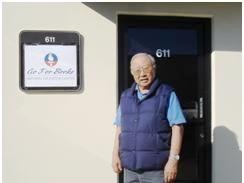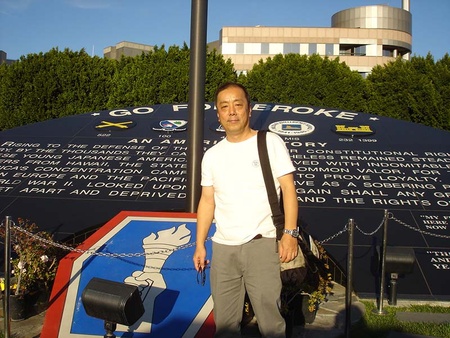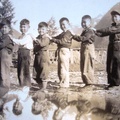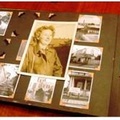California and Yokohama
Yokohama has a deep relationship with the United States of America, thanks to the contributions from Matthew C. Perry and General of the Army Douglas MacArthur. The relationship is especially strong with the cities of U.S. West Coast because of the direct route across the Pacific Ocean used by many people. During the eight months spanning from July 2011 until March 2012 I stayed in Los Angeles, where I was able to listen to lesser-known anecdotes told by several Americans who made an impact on Yokohama during the World War II era. California has a rich history in which those Americans took part. I would like to introduce some of these anecdotes to you.
A Nisei Goes to Yokohama
Little Tokyo in Downtown Los Angeles has the biggest Japanese community in the United States. As soon as I arrived there in August 2011, I met Hitoshi Sameshima who was a volunteer guide at the Japanese American National Museum.
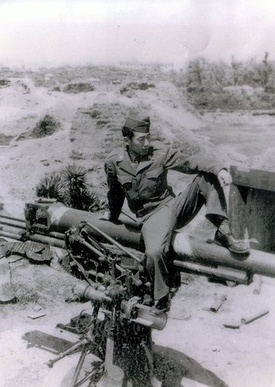
Hitoshi Sameshima at Nogeyama Anti-aircraft Gun Position, Yokohama (Photo courtesy of Hitoshi Sameshima)
Hitoshi was born in 1921 in Pasadena, CA to immigrant parents from the Kagoshima Prefecture of Japan. After diligently selling magazines and enrolling at University of Southern California, he and his family members were sent to an internment camp when the war started. He transferred to the University of Denver after pledging to the notorious loyalty questionnaires, which tested the loyalty of Japanese Americans to the United States. However, he was drafted in July 1944 immediately before graduation and went to Military Intelligence Service Language School at Fort Snelling.
The United States Army created several schools for Japanese personnel education for psychological operations of collecting information and advertising, while forcing the Japanese Americans to work in the Military Intelligence Service (MIS). On October 1945, Hitoshi arrived in Yokohama as a member of the Allied Translator and Interpreter Section (ATIS) of MIS, accompanied by the U.S. Eighth Army led by Robert Lawrence Eichelberger. The journey to Yokohama was made via Luzon and the Pacific Ocean front. At Yokohama, Hitoshi was an interpreter for the Class B and C war crimes trials. Hitoshi told episodes about the trials, such as cheering up a struggling nurse summoned by a U.S. Forces Court and being thanked for it.
Around that time, he gave the USA Consulate a notice of intended marriage with a woman he met at Myorenji Temple in Yokohama, but there were no receptions or wedding rings. The woman graduated from Ferris Girls’ Scool—what a small world. Hitoshi’s wife was hospitalized after the married couple first came to the United States, but the married couple traveled to the foreign cemetery, Yamashita Park, Kamakura, and Hakone when they were young. Hitoshi was smiling while talking about the enjoyable memories during their youth.
Hitoshi also talked about Go For Broke National Education Center located in Torrance, CA.
Kenjiro Akune, whom I met there, was born in Turlock, CA in 1923, rode the ship Asama-maru to Japan with his mother and four siblings when he was 10 years old, and spent 5 years in Kagoshima, his parents’ hometown. When he returned to the United States, he was able to make a living working with his older brother at a Miso shop in Little Tokyo. After the war started, he was placed in an internment camp, went to MIS Language School Camp Savage, became a member of the Office of War Information (OWI), and worked on advertisements promoting Japan to surrender along with prisoner interrogations in northern Burma. His colleagues included John Emerson and Karl Yoneda.
After the war ended, he came back to Japan through China and was hired as an interpreter at the Tokyo Tribunal of War Criminals and the Metropolitan Police Department. His older brother Harry Masami Akune was a member of the 11th Airborne Division that invaded Atsugi on August 28. The two younger brothers who stayed in Japan joined the Japanese military forces, and one of the brothers, Saburo, was in the Atsugi 302 Naval Aviation led by Yasuna Kozono, so the war between Japan and the U.S. seemed like a battle between brothers. Kenjiro was active in promoting the restoration of rights for the Japanese Americans, and in recognition of this, a monument was built behind the Japanese American National Museum.
* This article was originally published in Quarterly Yokohama (Summer 2012 vol.37), issued by Kanagawa Newspaper.
© 2012 Hiroshi Onishi


